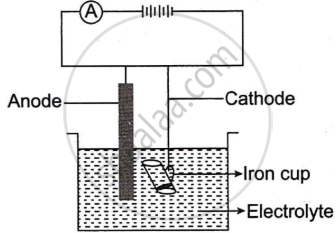Advertisements
Advertisements
प्रश्न
The following sketch represents the electroplating of an Iron cup with Nickel metal.
Study the diagram and answer the following questions:

- During electroplating, the iron cup is placed at the cathode. Why?
- Name the ion that must be present in the electrolyte.
- State one condition that is necessary to ensure that the deposit is smooth, firm and even.
- Write the reaction taking place at the cathode.
- What change would you observe at the anode?
उत्तर
- In electroplating, the iron cup is put at the cathode because the cathode is a negative terminal that attracts metals that are positively charged. This leads to the reduction and formation of metal ions.
- The electrolyte used is a water-based solution of \[\ce{NiSO4}\], so the ions formed are \[\ce{Ni^{2+}, H+, SO_4^{2−}, OH−}\].
- To ensure smooth deposition, current should be passed slowly and over a longer period of time.
- Cathode: \[\ce{Ni^{2+} + 2e^- -> Ni}\] (Reduction)
- The anode, a Ni plate, is etched after the Ni ions finish in the electrolyte.
APPEARS IN
संबंधित प्रश्न
How is the following metallic oxide reduced? Write equations:
Iron (ll) oxide
How is the following metallic oxide reduced? Write the equation:
Zinc oxide
Write a balanced chemical equation for each of the following reactions :
(i) Reduction of copper (II) oxide by hydrogen
Give reason for the following:
Carbon anodes are used in the electrolytic extraction of aluminium.
Give equation for the following conversion: Ferric oxide to iron.
Write balanced equation for the following reaction:
Reduction of iron (III) oxide by carbon monoxide.
Name the following:
The compound formed by the reaction between calcium oxide and silica.
Name the following :
A metal oxide that can be reduced by hydrogen
Complete the following by selecting the correct option from the choices given :
The diavalent metal whose oxide is reduced to metal by electrolysis of its fused salt is ________
Write the observation for the following:
A paper dipped in potassium permanganate solution is put on the mouth of a test tube containing sulphur dioxide gas.
